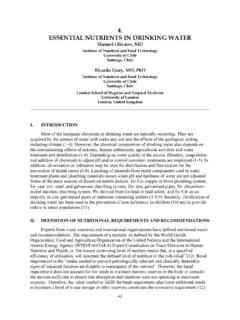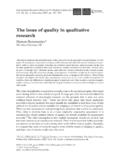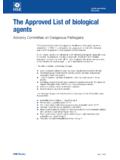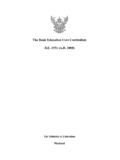Transcription of Guidelines for Drinking-Water Quality - Second …
1 Guidelines for Drinking-Water Quality - Second Edition - Volume 2 - HealthCriteria and Other Supporting InformationINTERNATIONAL PROGRAMME ON CHEMICAL SAFETYW orld Health OrganizationGeneva1996 WHO Library Cataloguing in Publication DataGuidelines for Drinking-Water Quality . - 2nd : Health criteria and other supporting information1. drinking water - standardsISBN 92 4 154480 5 (v. 2) (NLM Classification: WA 675)The World Health Organization welcomes requests for permission to reproduce or translate itspublications, in part or in full. Applications and enquiries should be addressed to the Office ofPublications, World Health Organization, Geneva, Switzerland, which will be glad to provide thelatest information on any changes made to the text, plans for new editions, and reprints andtranslations already available.
2 World Health Organization 1996 Publications of the World Health Organization enjoy copyright protection in accordance with theprovisions of Protocol 2 of the Universal Copyright Convention. All rights designations employed and the presentation of the material in this publication do not implythe expression of any opinion whatsoever on the part of the Secretariat of the World HealthOrganization concerning the legal status of any country, territory, city or area or of its authorities,or concerning the delimitation of its frontiers or mention of specific companies or of certain manufacturers' products does not imply that theyare endorsed or recommended by the World Health Organization in preference to others of asimilar nature that are not mentioned.
3 Errors and omissions excepted, the names of proprietaryproducts are distinguished by initial capital IN THE NETHERLANDSPRINTED IN AUSTRIA94/9960 - Mastercom/Wiener Verlag - 8000 Ordering informationGuidelines for Drinking-Water QualityVolume 2: Health criteria and Other Supporting InformationSecond edition1996, xvi + 973 pages [E, F*, S*]ISBN 92 4 154480 $ ; in developing countries: no. 1152404 PrefaceIn 1984 and 1985, the World Health Organization (WHO) published the first edition of Guidelinesfor Drinking-Water Quality in three volumes. The development of these Guidelines was organizedand carried out jointly by WHO headquarters and the WHO Regional Office for Europe (EURO).
4 In 1988, the decision was made within WHO to initiate the revision of the Guidelines . The workwas again shared between WHO headquarters and EURO. Within headquarters, both the unit forthe Prevention of Environmental Pollution (PEP) and the ILO/UNEP/WHO InternationalProgramme on Chemical Safety (IPCS) were involved, IPCS providing a major input to the healthrisk assessments of chemicals in revised Guidelines are being published in three volumes. Guideline values for variousconstituents of Drinking-Water are given in Volume 1, Recommendations together with essentialinformation required to understand the basis for the values.
5 Volume 2, Health criteria and othersupporting information, contains the criteria monographs prepared for each substance orcontaminant; the guideline values are based on these. Volume 3, Surveillance and control ofcommunity supplies, is intended to serve a very different purpose; it contains recommendationsand information concerning what needs to be done in small communities, particularly indeveloping countries, to safeguard their water preparation of the current edition of the Guidelines for Drinking-Water Quality covered a periodof four years and involved the participation of numerous institutions, over 200 experts from nearly40 different developing and developed countries and 18 meetings of the various coordination andreview groups.
6 The work of these institutions and scientists, whose names appear in Annex 1,was central to the completion of the Guidelines and is much each contaminant or substance considered, a lead country prepared a draft documentevaluating the risks for human health from exposure to the contaminant in Drinking-Water . Thefollowing countries prepared such evaluation documents: Canada, Denmark, Finland, Germany,Italy, Japan, Netherlands, Norway, Poland, Sweden, United Kingdom of Great Britain andNorthern Ireland and United States of the responsibility of a coordinator for each major aspect of the Guidelines , these draftevaluation documents were reviewed by several scientific institutions and selected experts, andcomments were incorporated by the coordinator and author prior to submission for finalevaluation by a review group.
7 The review group then took a decision as to the health riskassessment and proposed a guideline the preparation of draft evaluation documents and at the review group meetings, carefulconsideration was always given to previous risk assessments carried out by IPCS, in itsEnvironmental Health criteria monographs, the International Agency for Research on Cancer, thejoint FAO/WHO Meetings on Pesticide Residues, and the joint FAO/WHO Expert Committee onFood Additives, which evaluates contaminants such as lead and cadmium in addition to is clear that not all the chemicals that may be found in Drinking-Water were evaluated indeveloping these Guidelines .
8 Chemicals of importance to Member States which have not beenevaluated should be brought to the attention of WHO for inclusion in any future is planned to establish a continuing process of revision of the Guidelines for drinking -waterquality with a number of substances of agents subject to evaluation each year. Whereappropriate, addenda will be issued, containing evaluations of new substances or substancesalready evaluated for which new scientific information has become available. Substances forwhich provisional guideline values have been established will receive high priority for re-evaluation.
9 AcknowledgementsThe work of the following coordinators was crucial in the development of Volumes 1 and 2 of theGuidelines:J. K. Fawell, water Research Centre, England (inorganic constituents)J. R. Hickman, Department of National Health and Welfare, Canada (radioactive materials)U. Lurid, water Quality Institute, Denmark (organic constituents and pesticides)B. Mintz, Environmental Protection Agency, United States of America (disinfectants anddisinfectant by-products)E. B. Pike, water Research Centre, England (microbiology)The coordinator for Volume 3 of the Guidelines was J. Bartram of the Robens Institute of Healthand Safety, WHO coordinators were as follows:Headquarters:H.
10 Galal-Gorchev, International Programme on Chemical Safety;R. Helmer, Division of Environmental Office for Europe:X. Bonnefoy, Environment and Health;O. Espinoza, Environment and Marla Sheffer of Ottawa, Canada, was responsible for the scientific editing of the convening of the coordination and review group meetings was made possible by the financialsupport afforded to WHO by the Danish International Development Agency (DANIDA) and thefollowing sponsoring countries: Belgium, Canada, France, Italy, Netherlands, United Kingdom ofGreat Britain and Northern Ireland and United States of addition, financial contributions for the convening of the final task group meeting were receivedfrom the Norwegian Agency for Development Cooperation (NORAD), the United KingdomOverseas Development Administration (ODA) and the water Services Association in the UnitedKingdom, the Swedish International Development Authority (SIDA)

















